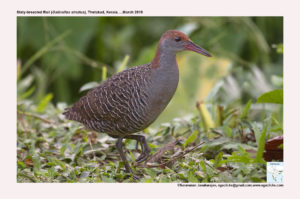Slaty-breasted Rail

Slaty-breasted Rail Gallirallus striatus
Etymology :
- Gallirallus : Latin word Gallus – fowl, farmyard cock; Rallus– genusof Rails.
- Striatus : Latin word striatus–
Distribution in India: Resident of Western Ghats, parts of Tamilnadu, Madhya Pradesh, West Bengal, Assam, Orissa, Andaman & Nicobar Islands in India.
Description: Size of 25–30 cm; wt. of 100–142 g. It is a medium-sized rail, with chestnut crown and nape, blue-grey breast, narrow white bars and spots on upperparts and wings, white-barred underparts, and fairly long, reddish bill. The female is duller on upperparts, and more whitish on belly. The immature is like adult but white barring is less distinct; upperparts, including crown and hindneck, are indistinctly streaked darker; breast is more brownish; underparts are paler. The juvenile is less patterned than immature, with white bars on upperparts largely absent. The races are separated on: size, race jouyiislargest; and overall colour with nominate. The race obscurior and paratermaare darkest, gularis and taiwanaarepalest
Habitat: It is found in wetlands of many types, including marshy meadows, reedmarsh, paddyfields, and mangrove, grassland and dry rice fields, in gardens and damp areas near villages, drainage ditches; and forest (Andaman). It is found up to 1850 m.
Food Habits: It eats worms, molluscs, crustaceans, insects and their larvae, spiders, and the seeds and shoots of marsh plants. It takes food from surface of ground, but also takes seeds and insects from vegetation by jumping up, or by perching on plants. It probes soft soil with bill for earthworms and insect larvae; picks up and sweeps aside fallen leaves and grasses; does not scratch with feet. It swims and dives well
Breeding Habits: They Breed in India and Sri Lanka in Jun–Oct; Sumatra in Jun, Dec; Java in Jan–Jul and Sept–Nov, but most in Mar–May; and in Philippines in Aug–Sept. They are monogamous. The nest is well concealed in thick vegetation at marsh edge, or in forest (Andaman). The nest is a pad of matted weeds, reed stems and grass, built on the ground or on dead reed debris. Both sexes build the nest, with predominantly the male doing the work. They lay a clutch of 5–9 eggs. The incubation period is 19–22 days. The incubation is done by both sexes, predominantly by female. The chicks leave nest soon after hatching. The chicks are fed and cared for by both parents.